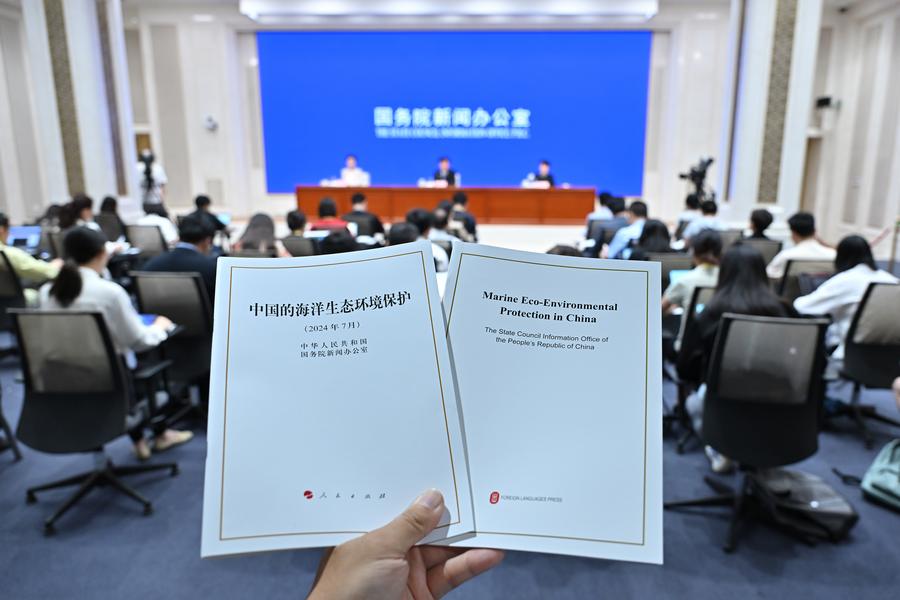


This photo taken on July 11, 2024 shows the Chinese and English copies of the white paper titled "Marine Eco-Environmental Protection in China" in Beijing, capital of China. (Xinhua/Li Xin)
BEIJING, July 11 (Xinhua) -- China has seen marked improvement in the quality of its marine environment and has been working hard on innovative new protection approaches, said a white paper issued on Thursday by China's State Council Information Office.
Through land-sea coordination and by increasing river-sea connectivity, it has effectively improved the marine eco-environment, said the white paper titled "Marine Eco-Environmental Protection in China."
Through comprehensive governance of key sea areas, land-sea coordination in pollution control, and building beautiful bays, China's nearshore water quality has improved. In 2023, the proportion of sea areas with good to excellent water quality saw a 21.3 percentage-point increase from 2012, according to the document.
The white paper shed light on China's comprehensive governance of key sea areas, such as the Bohai Sea, the Yangtze River Estuary-Hangzhou Bay, and the Pearl River Estuary, which are located at the strategic intersections of China's coast where high-quality development is in full swing.
An enclosed body of water, situated deep within a continent and connected to the open ocean only by straits, often features slow exchange rates, poor oceanic capacity and a high concentration of human activities, making it a challenge for marine environmental governance. The Chesapeake Bay in the United States, the Baltic Sea in Europe and the Seto Inland Sea in Japan have all seen years of governance efforts.
The Bohai Sea is China's only semi-enclosed inland sea, which experienced problems such as deteriorating coastal water quality, ecological degradation and resource depletion.
In order to alleviate the impact of land-sourced pollution on the marine environment, China has adopted robust measures to coordinate land-sea pollution control and monitor the key pathways that channel land-sourced pollutants into the sea, said the white paper.
Since 2018, China has launched two rounds of comprehensive eco-environmental campaigns in the Bohai Sea. These efforts have yielded significant results. By 2023, the proportion of nearshore waters with good to excellent quality in the region rose to 83.5 percent, marking an 18.1 percentage-point increase from 2018 levels.
China's governance model, which prioritizes land and sea coordination, has emerged as a new global solution for the ecological environment of inland seas, Vice Minister of Ecology and Environment Guo Fang told a press conference on the white paper on Thursday.
In 2023, 167 out of 283 bays in China saw more than 85 percent of their waters in good or excellent condition, providing a thriving habitat for species such as the Bryde's whale, the Chinese white dolphin and the black-faced spoonbill, Guo noted.
China is a major maritime country and one of the countries with the richest marine biodiversity in the world, Guo said, adding that the country has documented more than 28,000 marine species, accounting for 11 percent of the world's total known marine species.
China attaches great importance to marine biodiversity conservation, which is evident in its continuous efforts to protect, restore and manage its marine ecosystems, Guo said.
Since the 13th Five-Year Plan period (2016-2020), China has made substantial strides in coastal restoration, with 1,680 kilometers of coastline and over 750,000 mu (50,000 hectares) of coastal wetlands harnessed and restored, said Sun Shuxian, vice minister of natural resources and head of the State Oceanic Administration, at the press conference.
These efforts have enhanced the structure and function of typical marine ecosystems, and made significant contributions to the recovery of habitats of endangered species, such as the Chinese white dolphin and the Chinese horseshoe crab.
These efforts have also reduced disruptions to the East Asian-Australasian Flyway, one of the world's most important migratory flyways, which supports approximately 8 million migratory shorebirds moving annually across the continent.
Through high-level eco-environmental protection, China strives to foster new impetus for and new advantages in its high-quality development, the white paper noted.
China is making significant progress in the adoption of green ships and new energy vessels. Its first methanol dual-fueled ship can reduce carbon emissions by 75 percent, nitrogen emissions by 15 percent, and sulfur and particulate matter emissions by 99 percent, according to the white paper.
The robust recovery and quality improvement in China's marine economy have positioned it as a new engine for national economic growth, Sun said.
In 2023, China's gross ocean product topped 9.9 trillion yuan (about 1.39 trillion U.S. dollars), a 6 percent increase from the previous year.
点击右上角![]() 微信好友
微信好友
 朋友圈
朋友圈

请使用浏览器分享功能进行分享
